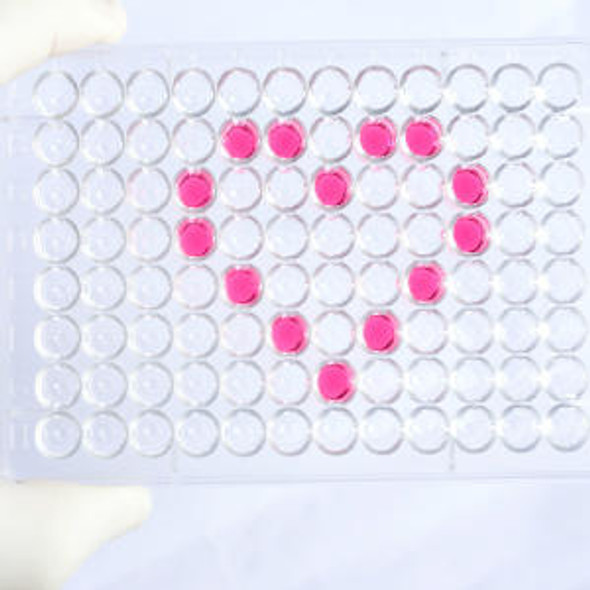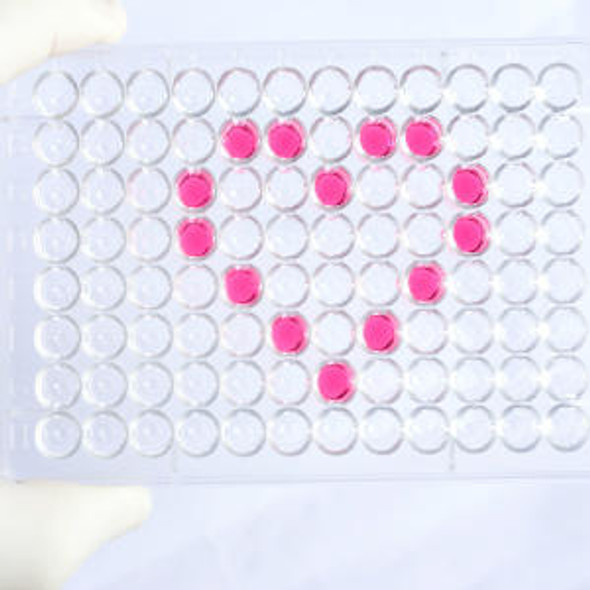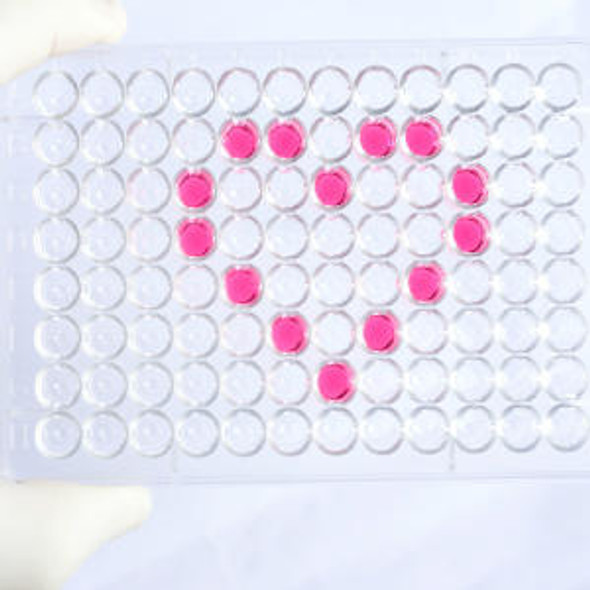Human LRRK2 / Leucine-rich repeat serine / threonine-protein kinase 2 ELISA Kit
- SKU:
- HUFI01480
- Product Type:
- ELISA Kit
- Size:
- 96 Assays
- Uniprot:
- Q5S007
- Sensitivity:
- 0.094ng/ml
- Range:
- 0.156-10ng/ml
- ELISA Type:
- Sandwich ELISA, Double Antibody
- Synonyms:
- LRRK2, AURA17, Dardarin, PARK8, ROCO2, augmented in rheumatoid arthritis 17, leucine-rich repeat kinase 2, leucine-rich repeat serine, threonine-protein kinase 2, RIPK7
- Reactivity:
- Human
Description
| Product Name: | Human LRRK2 / Leucine-rich repeat serine / threonine-protein kinase 2 ELISA Kit |
| Product Code: | HUFI01480 |
| Size: | 96 Assays |
| Alias: | LRRK2, AURA17, Dardarin, PARK8, ROCO2, augmented in rheumatoid arthritis 17, leucine-rich repeat kinase 2, leucine-rich repeat serine, threonine-protein kinase 2, RIPK7 |
| Detection method: | Sandwich ELISA, Double Antibody |
| Application: | This immunoassay kit allows for the in vitro quantitative determination of Human LRRK2 concentrations in serum plasma and other biological fluids. |
| Sensitivity: | 0.094ng/ml |
| Range: | 0.156-10ng/ml |
| Storage: | 4°C for 6 months |
| Note: | For Research Use Only |
| Recovery: | Matrices listed below were spiked with certain level of Human LRRK2 and the recovery rates were calculated by comparing the measured value to the expected amount of Human LRRK2 in samples. | ||||||||||||||||
| |||||||||||||||||
| Linearity: | The linearity of the kit was assayed by testing samples spiked with appropriate concentration of Human LRRK2 and their serial dilutions. The results were demonstrated by the percentage of calculated concentration to the expected. | ||||||||||||||||
| |||||||||||||||||
| CV(%): | Intra-Assay: CV<8% Inter-Assay: CV<10% |
| Component | Quantity | Storage |
| ELISA Microplate (Dismountable) | 8×12 strips | 4°C for 6 months |
| Lyophilized Standard | 2 | 4°C/-20°C |
| Sample/Standard Dilution Buffer | 20ml | 4°C |
| Biotin-labeled Antibody(Concentrated) | 120ul | 4°C (Protect from light) |
| Antibody Dilution Buffer | 10ml | 4°C |
| HRP-Streptavidin Conjugate(SABC) | 120ul | 4°C (Protect from light) |
| SABC Dilution Buffer | 10ml | 4°C |
| TMB Substrate | 10ml | 4°C (Protect from light) |
| Stop Solution | 10ml | 4°C |
| Wash Buffer(25X) | 30ml | 4°C |
| Plate Sealer | 5 | - |
Other materials and equipment required:
- Microplate reader with 450 nm wavelength filter
- Multichannel Pipette, Pipette, microcentrifuge tubes and disposable pipette tips
- Incubator
- Deionized or distilled water
- Absorbent paper
- Buffer resevoir
| Uniprot | Q5S007 |
| UniProt Protein Function: | LRRK2: a large multidomain protein kinase with a TKL-type kinase domain, multiple protein-protein interaction domains and a mitochondrial Rho domain (MIRO). May play a role in the etiology of Parkinson disease. May also have GTPase activity. Positively regulates autophagy through a calcium-dependent activation of the CaMKK/AMPK signaling pathway. The process involves activation of nicotinic acid adenine dinucleotide phosphate (NAADP) receptors, increase in lysosomal pH, and calcium release from lysosomes. Interacts with PARK2, PRDX3 and TPCN2. Expressed throughout the adult brain, but at a lower level than in heart and liver. Expressed in the cerebellum, cerebral cortex, medulla, spinal cord occipital pole, frontal lobe, temporal lobe and putamen. Expression is particularly high in brain dopaminoceptive areas. Defects in LRRK2 are the cause of Parkinson disease type 8 (PARK8). A slowly progressive neurodegenerative disorder characterized by bradykinesia, rigidity, resting tremor, postural instability, neuronal loss in the substantia nigra, and the presence of neurofibrillary MAPT (tau)-positive and Lewy bodies in some patients. |
| UniProt Protein Details: | Protein type:Protein kinase, TKL; Kinase, protein; Protein kinase, Ser/Thr (non-receptor); EC 2.7.11.1; TKL group; LRRK family Chromosomal Location of Human Ortholog: 12q12 Cellular Component: axon; caveola; cell junction; cell soma; cytoplasm; cytoplasmic vesicle; cytosol; dendrite; dendrite cytoplasm; endoplasmic reticulum; endosome; extracellular space; Golgi apparatus; Golgi-associated vesicle; growth cone; inclusion body; intracellular; lysosome; microvillus; mitochondrial inner membrane; mitochondrial matrix; mitochondrial membrane; mitochondrial outer membrane; mitochondrion; neuron projection; perikaryon; plasma membrane; ribonucleoprotein complex; synaptic vesicle membrane; terminal button; trans-Golgi network Molecular Function:actin binding; ATP binding; clathrin binding; glycoprotein binding; GTP binding; GTP-dependent protein kinase activity; GTPase activator activity; GTPase activity; identical protein binding; kinase activity; MAP kinase kinase activity; microtubule binding; protein binding; protein homodimerization activity; protein kinase A binding; protein kinase activity; protein serine/threonine kinase activity; receptor signaling complex scaffold activity; Rho GTPase binding; SNARE binding; syntaxin-1 binding; tubulin binding Biological Process: activation of MAPK activity; activation of MAPKK activity; autophagy; calcium-mediated signaling; cellular response to starvation; determination of adult life span; endocytosis; Golgi organization and biogenesis; GTP metabolic process; intracellular distribution of mitochondria; lysosome organization and biogenesis; MAPKKK cascade; mitochondrion localization; mitochondrion organization and biogenesis; negative regulation of macroautophagy; negative regulation of protein amino acid phosphorylation; negative regulation of protein binding; neurite morphogenesis; neuromuscular junction development; olfactory bulb development; peptidyl-serine phosphorylation; peptidyl-threonine phosphorylation; phosphorylation; positive regulation of autophagy; positive regulation of dopamine receptor signaling pathway; positive regulation of GTPase activity; positive regulation of MAP kinase activity; positive regulation of programmed cell death; positive regulation of proteasomal ubiquitin-dependent protein catabolic process; positive regulation of protein amino acid phosphorylation; positive regulation of protein binding; positive regulation of protein ubiquitination; protein amino acid autophosphorylation; protein amino acid phosphorylation; regulation of autophagy; regulation of dopamine receptor signaling pathway; regulation of excitatory postsynaptic membrane potential; regulation of locomotion; regulation of membrane potential; regulation of mitochondrial depolarization; regulation of neuron maturation; regulation of synaptic transmission, glutamatergic; response to oxidative stress; small GTPase mediated signal transduction; tangential migration from the subventricular zone to the olfactory bulb; Wnt receptor signaling pathway through beta-catenin Disease: Parkinson Disease 8, Autosomal Dominant |
| NCBI Summary: | This gene is a member of the leucine-rich repeat kinase family and encodes a protein with an ankryin repeat region, a leucine-rich repeat (LRR) domain, a kinase domain, a DFG-like motif, a RAS domain, a GTPase domain, a MLK-like domain, and a WD40 domain. The protein is present largely in the cytoplasm but also associates with the mitochondrial outer membrane. Mutations in this gene have been associated with Parkinson disease-8. [provided by RefSeq, Jul 2008] |
| UniProt Code: | Q5S007 |
| NCBI GenInfo Identifier: | 294862450 |
| NCBI Gene ID: | 120892 |
| NCBI Accession: | Q5S007.2 |
| UniProt Secondary Accession: | Q5S007,Q6ZS50, Q8NCX9, A6NJU2, |
| UniProt Related Accession: | Q5S007 |
| Molecular Weight: | 286,103 Da |
| NCBI Full Name: | Leucine-rich repeat serine/threonine-protein kinase 2 |
| NCBI Synonym Full Names: | leucine-rich repeat kinase 2 |
| NCBI Official Symbol: | LRRK2 |
| NCBI Official Synonym Symbols: | PARK8; RIPK7; ROCO2; AURA17; DARDARIN |
| NCBI Protein Information: | leucine-rich repeat serine/threonine-protein kinase 2 |
| UniProt Protein Name: | Leucine-rich repeat serine/threonine-protein kinase 2 |
| UniProt Synonym Protein Names: | Dardarin |
| Protein Family: | Leucine-rich repeat serine/threonine-protein kinase |
| UniProt Gene Name: | LRRK2 |
| UniProt Entry Name: | LRRK2_HUMAN |
*Note: Protocols are specific to each batch/lot. For the correct instructions please follow the protocol included in your kit.
Before adding to wells, equilibrate the SABC working solution and TMB substrate for at least 30 min at 37°C. When diluting samples and reagents, they must be mixed completely and evenly. It is recommended to plot a standard curve for each test.
| Step | Protocol |
| 1. | Set standard, test sample and control (zero) wells on the pre-coated plate respectively, and then, record their positions. It is recommended to measure each standard and sample in duplicate. Wash plate 2 times before adding standard, sample and control (zero) wells! |
| 2. | Aliquot 0.1ml standard solutions into the standard wells. |
| 3. | Add 0.1 ml of Sample / Standard dilution buffer into the control (zero) well. |
| 4. | Add 0.1 ml of properly diluted sample ( Human serum, plasma, tissue homogenates and other biological fluids.) into test sample wells. |
| 5. | Seal the plate with a cover and incubate at 37 °C for 90 min. |
| 6. | Remove the cover and discard the plate content, clap the plate on the absorbent filter papers or other absorbent material. Do NOT let the wells completely dry at any time. Wash plate X2. |
| 7. | Add 0.1 ml of Biotin- detection antibody working solution into the above wells (standard, test sample & zero wells). Add the solution at the bottom of each well without touching the side wall. |
| 8. | Seal the plate with a cover and incubate at 37°C for 60 min. |
| 9. | Remove the cover, and wash plate 3 times with Wash buffer. Let wash buffer rest in wells for 1 min between each wash. |
| 10. | Add 0.1 ml of SABC working solution into each well, cover the plate and incubate at 37°C for 30 min. |
| 11. | Remove the cover and wash plate 5 times with Wash buffer, and each time let the wash buffer stay in the wells for 1-2 min. |
| 12. | Add 90 µl of TMB substrate into each well, cover the plate and incubate at 37°C in dark within 10-20 min. (Note: This incubation time is for reference use only, the optimal time should be determined by end user.) And the shades of blue can be seen in the first 3-4 wells (with most concentrated standard solutions), the other wells show no obvious color. |
| 13. | Add 50 µl of Stop solution into each well and mix thoroughly. The color changes into yellow immediately. |
| 14. | Read the O.D. absorbance at 450 nm in a microplate reader immediately after adding the stop solution. |
When carrying out an ELISA assay it is important to prepare your samples in order to achieve the best possible results. Below we have a list of procedures for the preparation of samples for different sample types.
| Sample Type | Protocol |
| Serum | If using serum separator tubes, allow samples to clot for 30 minutes at room temperature. Centrifuge for 10 minutes at 1,000x g. Collect the serum fraction and assay promptly or aliquot and store the samples at -80°C. Avoid multiple freeze-thaw cycles. If serum separator tubes are not being used, allow samples to clot overnight at 2-8°C. Centrifuge for 10 minutes at 1,000x g. Remove serum and assay promptly or aliquot and store the samples at -80°C. Avoid multiple freeze-thaw cycles. |
| Plasma | Collect plasma using EDTA or heparin as an anticoagulant. Centrifuge samples at 4°C for 15 mins at 1000 × g within 30 mins of collection. Collect the plasma fraction and assay promptly or aliquot and store the samples at -80°C. Avoid multiple freeze-thaw cycles. Note: Over haemolysed samples are not suitable for use with this kit. |
| Urine & Cerebrospinal Fluid | Collect the urine (mid-stream) in a sterile container, centrifuge for 20 mins at 2000-3000 rpm. Remove supernatant and assay immediately. If any precipitation is detected, repeat the centrifugation step. A similar protocol can be used for cerebrospinal fluid. |
| Cell culture supernatant | Collect the cell culture media by pipette, followed by centrifugation at 4°C for 20 mins at 1500 rpm. Collect the clear supernatant and assay immediately. |
| Cell lysates | Solubilize cells in lysis buffer and allow to sit on ice for 30 minutes. Centrifuge tubes at 14,000 x g for 5 minutes to remove insoluble material. Aliquot the supernatant into a new tube and discard the remaining whole cell extract. Quantify total protein concentration using a total protein assay. Assay immediately or aliquot and store at ≤ -20 °C. |
| Tissue homogenates | The preparation of tissue homogenates will vary depending upon tissue type. Rinse tissue with 1X PBS to remove excess blood & homogenize in 20ml of 1X PBS (including protease inhibitors) and store overnight at ≤ -20°C. Two freeze-thaw cycles are required to break the cell membranes. To further disrupt the cell membranes you can sonicate the samples. Centrifuge homogenates for 5 mins at 5000xg. Remove the supernatant and assay immediately or aliquot and store at -20°C or -80°C. |
| Tissue lysates | Rinse tissue with PBS, cut into 1-2 mm pieces, and homogenize with a tissue homogenizer in PBS. Add an equal volume of RIPA buffer containing protease inhibitors and lyse tissues at room temperature for 30 minutes with gentle agitation. Centrifuge to remove debris. Quantify total protein concentration using a total protein assay. Assay immediately or aliquot and store at ≤ -20 °C. |
| Breast Milk | Collect milk samples and centrifuge at 10,000 x g for 60 min at 4°C. Aliquot the supernatant and assay. For long term use, store samples at -80°C. Minimize freeze/thaw cycles. |









